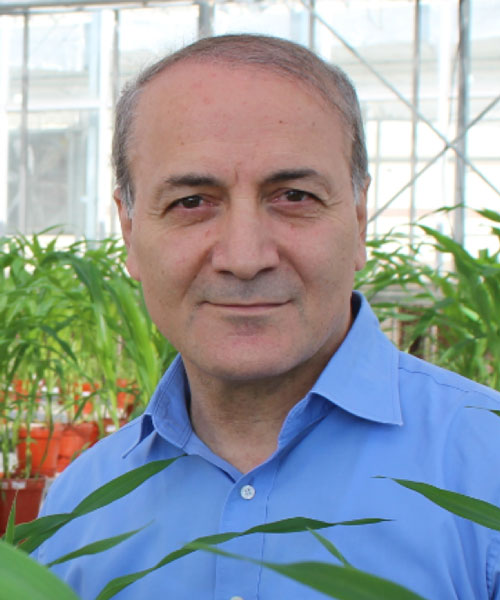Many plants react to environmental stress, and in doing so they offer a tool for humans to intervene to counteract climate change impact. Cereals are no exception. Often the number of their flowers, or inflorescence, is lower than expected due to a combination of genetics and environmental factors.
Growth and development of their flowers reflects on shape and size of grains, which are generated by reproductive organs bound to inflorescence. This ultimately has an impact on yield. Controlling number and size of flowers could therefore lead to richer harvest: an important result given that more than 50% of calories consumed today worldwide come from cereal grains.
"We have been studying the mechanisms responsible for the inflorescence shape in higher plants, particularly in rice, at the molecular level," TWAS Prize winner Zhang Dabing told an audience at the Academy's General Meeting. "And through a combination of cell biology, biochemistry and informatics, we have identified a number of genes that modulate cereal's flower number."
Strategies to improve agricultural practices and restore the nutritious potential of exhausted soil were prominent in TWAS Prize presentations, demonstrating scientists' commitment to the search for solutions to problems affecting local communities.
Zhang was educated and trained in plant biology and molecular genetics in China. In 1998 he earned a Ph.D in Plant Molecular Genetics from Shanghai Institute of Plant Physiology and Ecology, Chinese Academy of Sciences (CAS) Shanghai, China.
As his career moved on, he was appointed full professor at Shanghai Jiao Tong University (SJTU), in 2004. In 2015 he was promoted as chair professor at SJTU, and the same year he took a joint professorship position to work between SJTU and the University of Adelaide, running the joint laboratory on plant science and breeding.
In his scientific investigations he has addressed the molecular control of rice male sterility, which affects reproduction, holding seven patents related to the control of rice male sterility. In addition, he and his team have identified ten genes that are critical for anther development and pollen formation. Anthers are the part of a stamen that contains pollen.
For his efforts to understand the molecular mechanisms of reproduction in higher plants, especially rice, and for his achievements he received the 2018 TWAS Prize in Agricultural Science.
Using genetics and biochemistry, Zhang and his team also have helped clarify agricultural biochemical pathways sensitive to climate change. "We found that climate change has an impact on some rice genes that control male plants' fertility under temperature fluctuations," he explained in his presentation on 29 November 2018. Above 23oC, a rice variety is sterile because one of its genes is inactivated. With temperatures lower than 23oC, fertility is recovered.
In addition, he has generated and characterized more than 660 rice mutants carrying pollen defects, different number of seeds and flower formation, and obtained important results also on barley.
Cereals were the focus of another presentation, at TWAS's General Meeting. Ismail Cakmak, a 2016 TWAS Prize winner in agriculture from Sabanci University in Turkey offered the audience a broad perspective on how to fight human malnutrition using biofortification, i.e. enrichment of cereals.
"We all know that hunger ... affects about 800 million people in the world," he said in his presentation. "What we tend to ignore is that hidden hunger – lack of food vitamins and micronutrients such as vitamin A, iron and zinc – impacts on as many as 2 billion people."
Numerical comparison is striking, as Cakmak showed: with 1.2 million deaths per year due to road accidents; 1.3 per year due to tubercolosis and 1.8 due to HIV/AIDS, deaths due to micronutrient malnutrition are as high as 9 million per year.
Noting that 5.6 million children under 5 died in 2016, he added: "Almost half of these early child deaths were due to nutritional conditions that could be prevented through simple and affordable interventions."
Cakmak is now a professor of molecular biology, genetics and bioengineering at Sabanci University. Before joining the University in 2000, he was at Cukurova University in Adana, Turkey. An expert in soil and plant physiology, he serves in the editorial board of the journal Plant and Soil, and has edited the section entitled "Impacts of Agriculture on Human Health and Nutrition", published by UNESCO.
Malnutrition causes are rooted into two factors: scarcity of micronutrients in the soil, due to agricultural practices that produce high yields but reduce nutrients; and insufficient intake of the right amount and right quality of food. Lack of soil micronutrients like zinc very often overlaps, on the world map, with human zinc deficiency.
And as Cakmak's research demonstrates, zinc in the soil, along with potassium and magnesium, help plants to increase tolerance to environmental stress like heat, drought and light intensity. Zinc has a pivotal role in humans, too: along with iodine and iron, it mitigates health complications and chronic diseases.
"To be a good source of zinc for humans, cereal grains should contain 40-60 mg of zinc per kilogram. But currently we are barely reaching 20-30 mg/kg," Cakmak said. "Nutritionists tend to emphasize medical approaches to solve malnutrition problems, such as micronutrient supplements. But health comes from the farm, not from the pharmacy," he quipped. Micronutrient supplements or artificial fortification of foods with micronutrients may not be long-term solutions and cost effective approaches, especially in the rural areas.
This, he believes, is why the fight against malnutrition should start from the soil. Cakmak is currently the coordinator of an international project called the "Harvest Zinc Project", which began in 2008 and is now in its final three-year phase.
The project involves 13 developing and emerging countries, and aims at biofortifying staple food crops by applying essential micronutrient fertilizer formulations to soil and leaves. Test crops currently under investigation are wheat, rice and maize. The Harvest Zinc Pproject has been developed under HarvestPlus program that is coordinated by the International Food Policy Research Institute in Washington D.C., and the International Center for Tropical Agriculture in Colombia, and has the Bill & Melinda Gates Foundation as the main sponsor.
Results of the research carried out at Harvest Zinc Project, especially on wheat and rice emphasize the feasibility and importance of biofortification of food crops by adding micronutrients to fertilizer formulations as well as in the commonly applied insecticides and pesticides. This strategy may greatly help to control the development of cognitive functions such as learning, reasoning, attention and memory, which are markedly dependent on the presence of specific nutrients at early ages. In addition, it may help better functioning of the immune system against different type of diseases.
"Concentrations of zinc – but also iodine and selenium in wheat after application of a micronutrient cocktail solutions on crops in China, Pakistan, India, Turkey and South Africa – gave positive results: concentration of these micronutrients increased up to levels which are sufficient for a good human nutrition with micronutrients," he noted. "And maintenance of high micronutrient concentrations can be achieved easily, also by spraying them over the leaf tissue during the reproductive growth stage." Dr. Cakmak also emphasized that HarvestPlus program started to release micronutrient enriched new varieties after very successful breeding programs, and combining agronomic and plant breeding approaches create significant additive and synergistic impacts on grain concentration of micronutrients.
Consuming biofortified foods is a strategy that should be pursued in the years ahead, Cakmak concluded, as it could significantly minimize hidden hunger and boost nutrition security.
Cristina Serra

